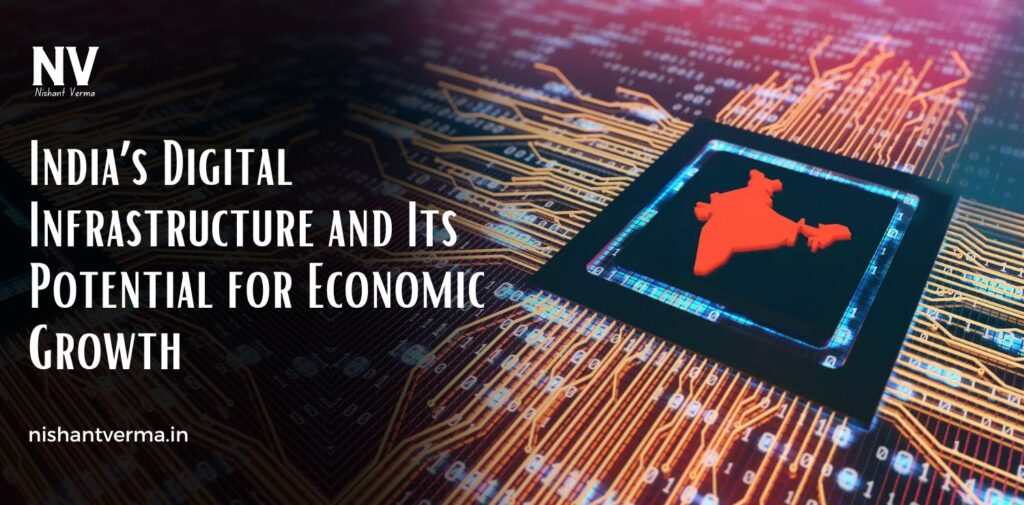India, with its booming population, rapidly expanding middle class, and strong entrepreneurial spirit, stands at the threshold of significant economic transformation. A key driver of this change is India’s evolving digital infrastructure, which holds immense potential to fuel the country’s economic growth. In today’s world, where technology shapes every aspect of business and everyday life, India’s push towards improving its digital infrastructure is setting the stage for a more inclusive, efficient, and globally connected economy. This article explores the role of digital infrastructure in India’s growth and its potential to drive economic development.
Understanding India Digital Infrastructure
India digital infrastructure refers to the systems, networks, and platforms that support digital activities such as internet access, mobile networks, data storage, digital payments, and cloud computing. Over the past few years, India has made significant strides in enhancing its digital infrastructure, with notable improvements in internet penetration, mobile connectivity, and government initiatives.
For example, the rollout of the BharatNet project aims to connect rural India to high-speed internet, enabling better access to education, healthcare, and government services. Similarly, the Digital India initiative launched in 2015 focuses on providing digital services to citizens, including e-governance, digital payments, and online education platforms. These developments have paved the way for a more connected and digitally empowered nation, unlocking opportunities for economic growth.

Broadband and Mobile Connectivity: The Backbone of Digital Growth
One of the most important aspects of digital infrastructure in India is the expansion of broadband and mobile connectivity. India is the second-largest internet user in the world, with over 700 million people having access to the internet as of 2021. Mobile phones, which are affordable and widely available, have played a crucial role in connecting urban and rural areas to the internet, making digital services accessible to a wider population.
The government’s efforts to enhance mobile connectivity, such as the introduction of 4G and the upcoming 5G technology, are expected to further boost the digital ecosystem. The expansion of broadband infrastructure into rural areas has been transformative. More than 250,000 villages across India are now connected to high-speed internet, making digital tools accessible for millions of people who previously lacked access.
Better connectivity has created new opportunities in e-commerce, digital banking, and remote working. It has also enabled businesses to reach customers in remote areas, reducing the geographic barriers to trade. As mobile internet usage continues to rise, India’s potential for digital growth becomes even more promising, setting the foundation for new industries and job creation.
Digital Payments and Financial Inclusion
One of the most significant outcomes of India digital infrastructure development has been the rise of digital payments. With platforms like Paytm, Google Pay, and PhonePe, India has become a global leader in digital transactions. The government’s Demonetization in 2016 and the subsequent push for cashless transactions accelerated the adoption of digital payments, particularly in urban areas.
Additionally, initiatives like the Jan Dhan Yojana (financial inclusion program) and Aadhaar (India’s unique identification system) have played a critical role in expanding access to banking services. Through digital payments, millions of previously unbanked individuals in rural and semi-urban areas are now able to receive government subsidies, transfer money, and access financial services.
The growing use of digital payments also drives economic activity, as it facilitates business transactions, reduces cash dependency, and increases transparency. Small businesses in remote areas can now expand their customer base by accepting online payments, and individuals can make purchases or pay bills from the comfort of their homes. As digital payment systems continue to evolve, India’s economy stands to benefit from greater efficiency and financial inclusivity.

E-Governance and Service Delivery
India digital infrastructure is also reshaping governance and public service delivery through the implementation of e-governance initiatives. The Digital India program has introduced various online platforms that allow citizens to access government services, file taxes, register properties, and even apply for subsidies and certificates online. This shift towards digital governance has not only made government services more accessible but has also made them more transparent and efficient.
For example, the Goods and Services Tax (GST) portal allows businesses to easily file tax returns, check compliance, and access relevant data in real time. Similarly, the Aadhaar-enabled Payment System has made it possible for the government to directly transfer benefits to citizens without the need for intermediaries, reducing fraud and leakage in subsidy distribution.
E-governance also reduces the time and effort required to access services, which enhances the ease of doing business and encourages more investment. Furthermore, as public services become more digitized, the government can use data to make better-informed decisions, resulting in more effective policies and faster implementation of development projects.
Opportunities for Startups and Innovation
India digital infrastructure is a catalyst for innovation, particularly in the startup ecosystem. With an increasing number of people getting online, there has been a rise in the demand for digital products and services. This growing demand, combined with the ease of access to digital tools, has led to a boom in the number of tech startups in India.
In recent years, India has become one of the largest startup ecosystems in the world, with successful ventures like Flipkart, Ola, Zomato, Byju’s, and many others. These startups leverage India digital infrastructure to scale rapidly, expand their reach, and access a global customer base. Whether it is in e-commerce, education, transportation, or health tech, digital platforms have enabled entrepreneurs to innovate and create solutions that address the country’s most pressing challenges.
Moreover, digital infrastructure also supports innovation by providing the necessary tools for research and development. Through cloud computing, artificial intelligence (AI), and big data analytics, startups can now access resources that were once available only to large corporations. These technologies are being used in diverse sectors, from agriculture to healthcare, to create more efficient and sustainable solutions.
The government has also been supportive of startups by creating a favorable regulatory environment, such as tax incentives and funding opportunities. This support, combined with India’s growing digital landscape, creates a fertile ground for innovation and entrepreneurship, which ultimately contributes to economic growth.

The Potential for Job Creation and Skill Development
As India digital infrastructure expands, it is expected to create millions of jobs across various sectors. The digital economy offers a wide range of employment opportunities, from IT services and software development to digital marketing and e-commerce logistics. Moreover, digital platforms are fostering the gig economy, where people can work remotely or freelance in various fields, such as content creation, web development, and data analysis.
To fully harness this potential, however, there is a need for skilled workers who are proficient in digital technologies. This is where skill development initiatives play a crucial role. The government and private sector have launched several programs aimed at enhancing digital literacy and providing vocational training in emerging technologies such as AI, machine learning, and cybersecurity.
With a large young population eager to join the workforce, India’s digital transformation provides an opportunity to equip millions with the skills needed for the future economy. As a result, the country can benefit from job creation in high-tech sectors and the development of a workforce that is capable of meeting the demands of a digital-first economy.
Challenges to Overcome
While India digital infrastructure holds immense potential, there are still several challenges that need to be addressed to fully unlock its benefits. One of the primary challenges is the digital divide between urban and rural areas. Despite significant progress, a large section of rural India still lacks reliable internet access and digital literacy. Bridging this gap is essential for ensuring that the benefits of digital infrastructure reach all segments of society.
Another challenge is cybersecurity. As India moves towards a more digitalized economy, ensuring the security of online transactions, data privacy, and protection against cyber threats becomes crucial. Strengthening cybersecurity infrastructure and creating awareness about safe online practices are key to sustaining digital growth.
Conclusion: A Promising Future
India digital infrastructure is one of the country’s greatest assets in driving economic growth. With ongoing efforts to expand connectivity, improve digital services, and foster innovation, India is well-positioned to tap into the full potential of its digital economy. From creating jobs and promoting financial inclusion to improving governance and enabling startups, the digital transformation of India promises to bring about significant changes in the way the country conducts business, accesses services, and creates wealth.
As the government, businesses, and citizens continue to embrace the digital revolution, India digital infrastructure will play a pivotal role in shaping a prosperous, inclusive, and sustainable future for the nation. The economic growth potential is vast, and with the right investments and policies, India’s digital ecosystem can propel the country into a new era of innovation and development.




